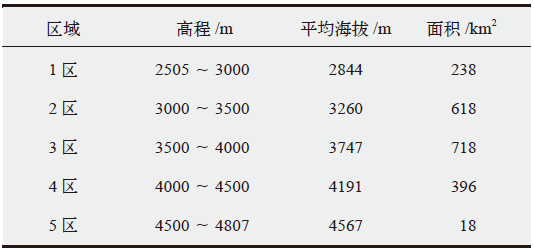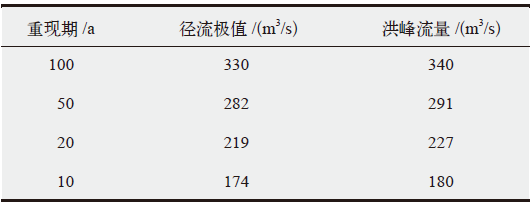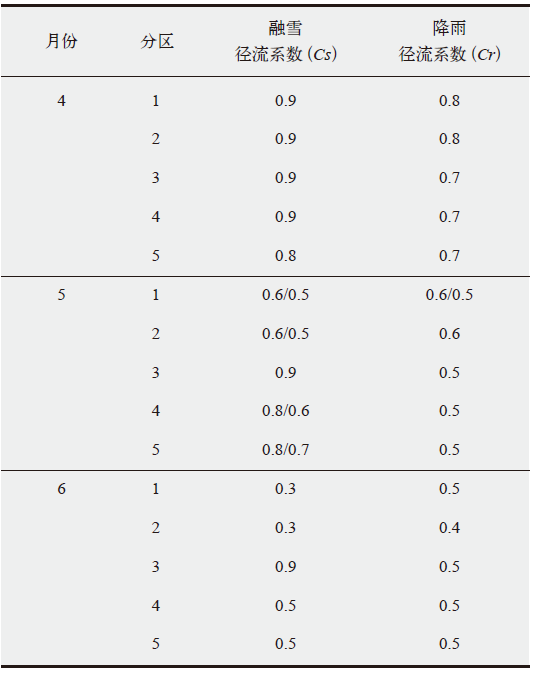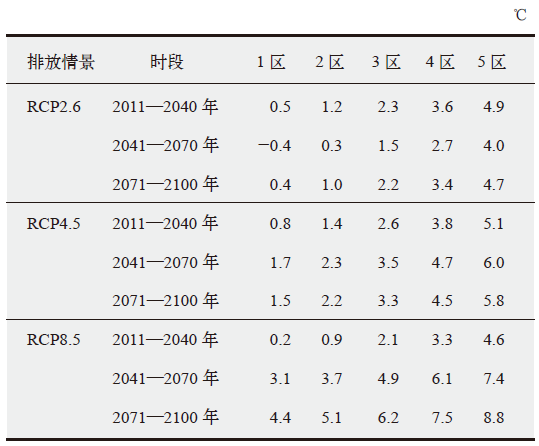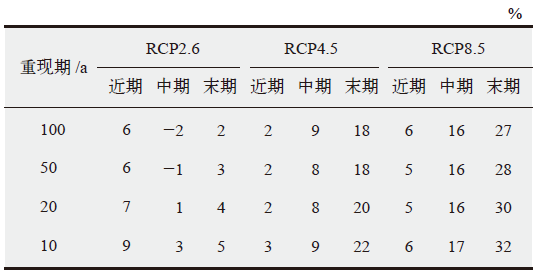气候变化研究进展 ›› 2020, Vol. 16 ›› Issue (6): 667-678.doi: 10.12006/j.issn.1673-1719.2020.006
气候变化背景下黑河上游春季融雪洪水预估研究
- 1 北京师范大学地表过程与资源生态国家重点实验室,北京 100875
2 甘肃省水文水资源局,兰州 730000
-
收稿日期:2020-01-08修回日期:2020-02-20出版日期:2020-11-30发布日期:2020-12-03 -
作者简介:朱光熙,男,硕士研究生,zhuguangxi@mail.bnu.edu.cn -
基金资助:国家自然科学基金项目(41671058);国家自然科学基金项目(1690145);北师大人才项目(12807-312232101)
Spring snowmelt flood estimate in the upper Heihe River under climate change
ZHU Guang-Xi1( ), XIAO Cun-De1, CHEN Bo1, ZHAO Ying-Dong2
), XIAO Cun-De1, CHEN Bo1, ZHAO Ying-Dong2
- 1 State Key Laboratory of Earth Surface Processes and Resource Ecology, Beijing Normal University, Beijing 100875, China
2 Hydrology and Water Resources Bureau of Gansu Province, Lanzhou 730000, China
-
Received:2020-01-08Revised:2020-02-20Online:2020-11-30Published:2020-12-03
摘要:
气候变暖将导致高山区冰冻圈加剧融化,一方面融水资源时空分布的不确定性增大;另一方面,融水洪水灾害发生的频度和强度也将发生改变。基于气象、水文数据和MODIS积雪覆盖数据,利用融雪径流模型(SRM),对1990—2012年共23年祁连山黑河札马什克控制区融雪期径流进行模拟与验证。结果表明:SRM在该流域具有较高的模拟精度(纳什系数为0.91),可用于分析和预估控制区径流强度变化。为此,采用黑河流域气温、降水降尺度数据,预估了未来气候变化背景下积雪范围变化及不同重现期洪水变化趋势。结果显示,与基准期相比,在RCP2.6、RCP4.5和RCP8.5情景下,最大积雪范围可减小3%~7%,且随着海拔升高,变化愈剧烈。RCP2.6情景下因气温和降水变化幅度较小,到21世纪末各重现期洪水强度保持在10%以内波动;RCP4.5情景下,各重现期洪水强度最高增大约20%;在RCP8.5情景下,各重现期洪水强度最高可增大超30%。相关分析结果显示,不同重现期洪水径流与气温和降水均具有较强相关性:重现期越长,洪峰与气温的相关性越大;重现期越短,洪峰与降水的相关性越大。通过预估气候变化背景下的融雪性洪水事件强度及重现期变化,有助于有效开展区域洪水风险管理、提高洪水资源的利用价值。
引用本文
朱光熙, 效存德, 陈波, 赵映东. 气候变化背景下黑河上游春季融雪洪水预估研究[J]. 气候变化研究进展, 2020, 16(6): 667-678.
ZHU Guang-Xi, XIAO Cun-De, CHEN Bo, ZHAO Ying-Dong. Spring snowmelt flood estimate in the upper Heihe River under climate change[J]. Climate Change Research, 2020, 16(6): 667-678.

图6 气候变化背景下1990—2012年札马什克站洪水重现期曲线(年最大径流序列)变化
Fig. 6 Change of flood return period curve (annual maximum runoff sequence) under climate change relative to 1990-2012 Zarmsk station data
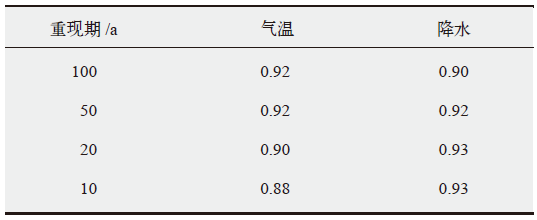 |
表7 气候变化背景下不同重现期模拟洪峰值与气温、降水皮尔逊相关系数
Table 7 Pearson correlation coefficient of simulated runoff value for different return periods with temperature and precipitation under climate change
 |
| [1] | 暴丽杰. 基于情景的上海浦东暴雨洪涝灾害脆弱性评估[D]. 上海: 上海师范大学, 2009. |
| Bao L J. Scenario-based vulnerability assessment of flood and flood disasters in Pudong, Shanghai[D]. Shanghai: Shanghai Normal University, 2009 (in Chinese) | |
| [2] | Abram N, Hilmi N, Petzold J, et al. Summary for policymakers [M/OL]//IPCC. Special report on the ocean and cryosphere inchanging climate. 2019 [2019-11-08]. https://www.ipcc.ch/srocc/chapter/summary-for-policymakers/ |
| [3] | IPCC. Special report on global warming of 1.5℃[M]. UK: Cambridge University Press, 2018 |
| [4] | 陈伏龙. 流域环境变化下玛纳斯河融雪洪水的水文效应及其防洪风险不确定性问题研究[D]. 天津: 天津大学, 2017. |
| Chen F L. Study on hydrological effect of snowmelt flood and uncertainty of flood control risk of Manas River under watershed environment changes[D]. Tianjin: Tianjin University, 2017 (in Chinese) | |
| [5] | 沈永平, 王国亚, 苏宏超, 等. 新疆阿尔泰山区克兰河上游水文过程对气候变暖的响应[J]. 冰川冻土, 2007 (6):845-854. |
| Shen Y P, Wang G Y, Su H C, et al. Responses of hydrological processes to climate warming in the upper reaches of the Kelan River in Altai Mountains, Xinjiang[J]. Glaciology and Geocryology, 2007 (6):845-854 (in Chinese) | |
| [6] | Ferguson R. Snowmelt runoff models[J]. Progress in Physical Geography, 1999,23(2):205-227 |
| [7] | 张鹏. 基于SRM模型的乌鲁木齐河源区冰雪径流模拟初探[D]. 兰州: 西北师范大学, 2016. |
| Zhang P. Preliminary study on simulation of ice and snow runoff in source region of Urumqi River based on SRM model[D]. Lanzhou: Northwest Normal University, 2016 (in Chinese) | |
| [8] | 俞永旺, 徐冰, 白东明 等. 天山北坡雀尔沟河春季融雪洪水的成因分析[J]. 干旱区研究, 1995 (3):15-20. |
| Yu Y W, Xu B, Bai D M, et al. Analysis on the causes of spring snowmelt flood in the Queergou River on the north slope of the Tianshan Mountains[J]. Arid Land Research, 1995 (3):15-20 (in Chinese) | |
| [9] | 谷爱莲. 石河子春季融雪型洪水的气候因素及其预报[J]. 新疆气象, 1987 (8):17-20. |
| Gu A L. Climatic factors and prediction of snowmelt flood in Shihezi in spring[J]. Xinjiang Meteorology, 1987 (8):17-20 | |
| [10] | 杨金明, 李诚志, 房世峰, 等. 新疆地区季节性融雪洪水模拟与预报研究[J]. 新疆大学学报: 自然科学版, 2019,36(1):80-88. |
| Yang J M, Li C Z, Fang S F, et al. Simulation and forecast of seasonal snowmelt flood in Xinjiang[J]. Journal of Xinjiang University: Natural Science Edition, 2019,36(1):80-88 (in Chinese) | |
| [11] | Adamowski J F. Development of a short-term river flood forecasting method for snowmelt driven floods based on wavelet and cross-wavelet analysis[J]. Journal of Hydrology, 2008,353(3):247-266 |
| [12] | Chen S H, Lin Y H, Chang L C, et al. The strategy of building a flood forecast model by neuro-fuzzy network[J]. Hydrological Processes, 2006,20(7):1525-1540 |
| [13] | 徐杰, 李致家, 马亚楠. 基于TOPKAPI模型的湿润流域洪水模拟[J]. 南水北调与水利科技, 2020,18(1):18-25. |
| Xu J, Li Z J, Ma Y N, et al. Flood simulation of humid watershed based on TOPKAPI model[J]. South-to-North Water Transfer and Water Conservancy Science and Technology, 2020,18(1):18-25 (in Chinese) | |
| [14] | 王飞, 朱仲元, 张鹏, 等. SRM融雪径流模型在锡林河流域的应用[J]. 干旱区研究, 2019,36(3):575-581. |
| Wang F, Zhu Z Y, Zhang P. Application of SRM snowmelt runoff model in Xilin River basin[J]. Arid Land Research, 2019,36(3):575-581 (in Chinese) | |
| [15] | 孜来布·阿不来提, 阿不都·沙拉木, 穆艾塔尔·赛地, 等. 融雪径流模型应用研究综述[J]. 新疆大学学报: 自然科学版, 2012,29(2):235-239. |
| Abuliti Z, Ssalam A, Saidi M, et al. A review on the application of snowmelt runoff models[J]. Journal of Xinjiang University: Natural Science Edition, 2012,29(2):235-239 (in Chinese) | |
| [16] | 乔鹏, 秦艳, 刘志辉. 基于能量平衡的分布式融雪径流模型[J]. 水文, 2011,31(3):22-26, 35. |
| Qiao P, Qin Y, Liu Z H. A distributed snowmelt runoff model based on energy balance[J]. Hydrology, 2011,31(3):22-26, 35 (in Chinese) | |
| [17] | Marks D, Domingo J, Susong D. A spatially distributed energy balance snowmelt model for application in mountain basins[J]. Hydrological Processes, 1999,13(12):1935-1959 |
| [18] | Kuchment L, Gelfan A. Long-term probabilistic forecasting of snowmelt flood characteristics and the forecast uncertainty[J]. Iahs Publication, 2007: 313213 |
| [19] | Zeinivand H, Smedt F D. Prediction of snowmelt floods with a distributed hydrological model using a physical snow mass and energy balance approach[J]. Natural Hazards, 2010,54(2):451-468 |
| [20] | 李弘毅, 王建. SRM融雪径流模型在黑河流域上游的模拟研究[J]. 冰川冻土, 2008 (5):769-775. |
| Li H Y, Wang J. Simulation study of SRM snowmelt runoff model in the upper reaches of Heihe River basin[J]. Glaciology and Geocryology, 2008 (5):769-775 | |
| [21] | 陈心池, 张利平, 闪丽洁, 等. 新疆山区中小河流洪水预报模型及其应用[J]. 干旱区研究, 2017,34(6):1426-1435. |
| Chen X C, Zhang L P, Shan L J, et al. Flood forecasting model of small and medium rivers in mountainous areas of Xinjiang and its application[J]. Arid Land Research, 2017,34(6):1426-1435 | |
| [22] | Tahir A A, Chevallier P, Arnaud Y, et al. Modeling snowmelt-runoff under climate scenarios in the Hunza River basin, Karakoram Range, Northern Pakistan[J]. Journal of Hydrology, 2011,409(1):104-117 |
| [23] | Tekeli A E, Akyürek Z, ?orman A A. Using MODIS snow cover maps in modeling snowmelt runoff process in the eastern part of Turkey[J]. Remote Sensing of Environment, 2005,97(2):216-230 |
| [24] | 曾蓉. 札马什克(二)水文站测验方案[J]. 甘肃水利水电技术, 2012,48(7):8-11. |
| Zeng R. Test scheme of Zamsk (II) hydrological station[J]. Gansu Water Resources and Hydropower Technology, 2012,48(7):8-11 (in Chinese) | |
| [25] | 陈心池, 张利平, 陈少丹, 等. SRM融雪径流模型在奎屯河流域洪水预报的应用[J]. 南水北调与水利科技, 2018,16(1):66-72. |
| Chen X C, Zhang L P, Chen S D, et al. Application of SRM snowmelt runoff model to flood forecast in Kuitun River basin[J]. South-to-North Water Transfers and Water Science & Technology, 2018,16(1):66-72 (in Chinese) | |
| [26] | 黄永生. SRM融雪径流模型参数不确定性研究[D]. 兰州: 西北师范大学, 2015. |
| Huang Y S. Study on uncertainty of parameters of SRM snowmelt runoff model[D]. Lanzhou: Northwest Normal University, 2015 | |
| [27] | 关明皓. SRM模型在大凌河流域融雪径流模拟中的运用研究[J]. 水利技术监督, 2016,24(3):71-73. |
| Guan M H. Application of SRM model to snowmelt runoff simulation in Daling River basin[J]. Technical Supervision in Water Resources, 2016,24(3):71-73 (in Chinese) | |
| [28] | 赵彦茜, 肖登攀, 柏会子. CMIP5气候模式对中国未来气候变化的预估和应用[J]. 气象科技, 2019,47(4):608-621. |
| Zhao Y Q, Xiao D P, Bai H Z. Forecast and application of CMIP5 climate model to China's future climate change[J]. Meteorological Science and Technology, 2019,47(4):608-621 (in Chinese) | |
| [29] | Chen B, Krajewski W F, Liu F. Estimating instantaneous peak flow from mean daily flow[J]. Hydrology Research, 2017,48(6):1474-1488 |
| [30] | Tiwari S, Kar S C, Bhatla R, et al. Temperature index based snowmelt runoff modelling for the Satluj River basin in the western Himalayas[J]. Meteorological Applications, 2018,25(4):302-313 |
| [31] | 王超, 赵传燕, 冯兆东. 黑河上游不同流域融雪过程的SRM模拟[J]. 兰州大学学报:自然科学版, 2011,47(3):1-8. |
| Wang C, Zhao C Y, Feng Z D. SRM simulation of snowmelt process in different watersheds in the upper reaches of Heihe River[J]. Journal of Lanzhou University: Natural Science, 2011,47(3):1-8 (in Chinese) | |
| [32] | Martinec J, Rango A, Major E. The snowmelt-runoff model (SRM) user's manual [R/OL]. 1983 [2020-01-08]. https://agris.fao.org/agris-search/search.do?recordID=US201300646142 |
| [33] | 程文举, 席海洋, 张经天. 黑河上游径流对极端气候变化的响应研究[J]. 高原气象, 2020 (1):120-129. |
| Cheng W J, Xi H Y, Zhang J T. Research on the response of runoff in the upper Heihe River to extreme climate change[J]. Plateau Meteorology, 2020 (1):120-129 (in Chinese) | |
| [34] | Boudhar A, Hanich L, Boulet G, et al. Evaluation of the snowmelt runoff model in the Moroccan High Atlas Mountains using two snow-cover estimates[J]. International Association of Scientific Hydrology Bulletin, 2009,54(6):1094-1113 |
| [35] | Gao X, Wu J, Shi Y, et al. Future changes in thermal comfort conditions over China based on multi-RegCM4 simulations[J]. Atmospheric and Oceanic Science Letters, 2018,11(4):291-299 |
| [1] | 张奇谋,王润,姜彤,陈松生. RCPs情景下汉江流域未来极端降水的模拟与预估[J]. 气候变化研究进展, 2020, 16(3): 276-286. |
| [2] | 张冬峰, 韩振宇, 石英. CSIRO Mk3.6.0模式及其驱动下RegCM4.4模式对中国气候变化的预估[J]. 气候变化研究进展, 2017, 13(6): 557-568. |
| [3] | 李晶 刘时银 韩海东 张勇 王建 魏俊锋. 天山托木尔峰南坡科其喀尔冰川流域径流模拟[J]. 气候变化研究进展, 2012, 8(5): 350-356. |
| [4] | 李博;周天军. 基于IPCC A1B情景的中国未来气候变化预估:多模式集合结果及其不确定性[J]. 气候变化研究进展, 2010, 6(04): 270-276. |
| 阅读次数 | ||||||
|
全文 |
|
|||||
|
摘要 |
|
|||||

